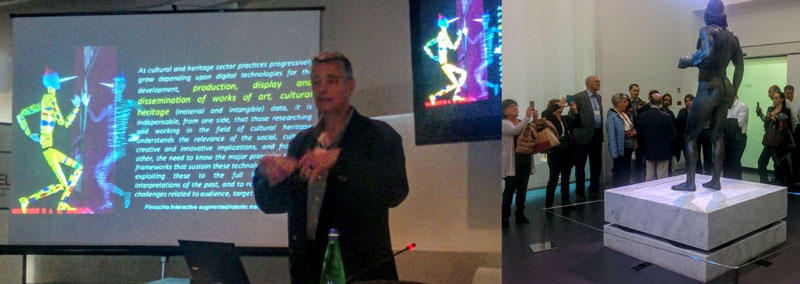by Davide Moroni, Ovidio Salvetti (ISTI-CNR) and Elena Console (TEA)
Over 40 researchers from academia and industry attended a workshop on Computational Intelligence for Multimedia Understanding (IWCIM) organized by the ERCIM MUSCLE working group in Reggio Calabria, Italy, 27-28 October 2016.
The workshop was held in close collaboration with the National Research Council of Italy (ISTI & BAM institutes), TEA sas, the University of Calabria and the Mediterranean University of Reggio Calabria, and was supported by the Archaeological Museum of Reggio Calabria, the Italian section of IEEE and ERCIM.
Reggio Calabria is the Italian city that hosts the Riace Bronzes, the two famous full-size Greek bronzes that were rediscovered in 1972 and are now exhibited at the National Museum of Magna Graecia. It was therefore natural to dedicate a special track of IWCIM to the theme “Understanding Cultural Heritage” as multimedia technologies have opened a wealth of possibilities for documentation, access, archiving and dissemination of our artistic patrimony. In addition, multimedia technologies are valuable tools in the diffusion of audiovisual material to the public at large, thus leaving the scholars’ niche and assuming new economic relevance in education and tourism. The key to exploiting the added value provided by the contextual nature of a multimedia object is understanding: besides increasing enormously the potential audience, multimedia can help specialists interpret their data, especially when a multidisciplinary expertise is required before beginning any concrete intervention on an artefact of historical, archaeological or artistic interest.
Two distinguished invited speakers used their expertise to broaden the perspectives of the computer scientist audience. Marina Bicchieri (ICRCPAL) showed us that books are composite objects, with much information hidden between the pages. Their fascinating history is also revealed by the physical support, the kind of ink/pigment/dye chosen and the pathologies they have suffered during their lifetime. Scholars and scientists could be helped by an interoperable and shared corpus of knowledge on past and current diagnostic technologies and procedures used in restoration.
The second invited talk was delivered by Franz Fischnaller (Accademia Albertina di Belle Arti di Torino, Italy & Museum European Mediterranean Civilizations, France). This talk explored new technologies in computer vision and imaging, immersive virtual reality (VR) and real-time interactive AR systems. These technologies provide interesting contexts, helping the public to engage in our cultural heritage, both inside and outside the museum.

Prof. Franz Fischnaller, invited speaker from Accademia Albertina di Belle Arti di Torino, Italy (left) and workshop attendants visiting the National Museum of Magna Graecia (right).
Underwater cultural heritage was also addressed by a dedicated special session. The use of Autonomous Underwater Vehicles (AUVs) to scout, survey and map the seabed was presented. AUVs can document ancient shipwrecks, providing rich multimedia content that can be turned into realistic 3D reconstructions. Multimedia creative technologies can then be used to propose virtual diving experiences, allowing the general public to explore otherwise inaccessible archaeological sites.
A final session on Big and Linked Data addressed aspects of social media analytics, forensic and semantic data stream processing.
20 papers were selected for oral presentation by the programme chairs Emanuele Salerno and Hana Charvatova. All accepted papers will be available through IEEE Xplore, thanks to the publication chairs Maria Trocan and Frédéric Amiel.
The social programme included a trip to the recently renewed National Archaeological Museum of Magna Graecia – thanks to the Director Carmelo Malacrino and to the Deputy Director Giacomo Maria Oliva who accompanied us during the visit. After the museum, Francesca Fatta showed us the facilities at the Lab for Survey and Representation of Mediterranean Architecture, which she directs at the Mediterranean University of Reggio Calabria.
Links:
http://wiki.ercim.eu/wg/MUSCLE/
http://www.teaprogetti.com/iwcim/
Please contact:
Davide Moroni, Ovidio Salvetti, ISTI-CNR, Italy
Elena Console, TEA, Italy











